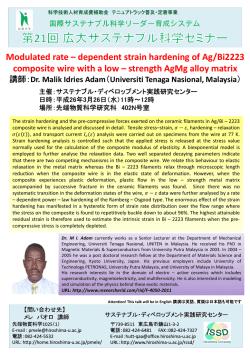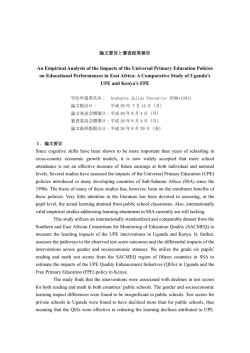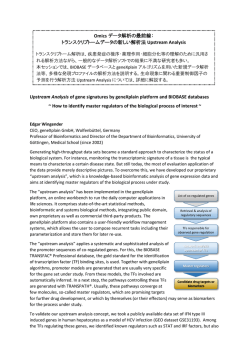
The main component causing the aging odor has been known to be
第18回知的財産翻訳検定<第10回和文英訳> 1級 バイオテクノロジー 標準解答 【背景技術】 加齢臭は、アルデヒド類に分類されるノネナールが主な原因成分であることが知られ ている。アルデヒド分解酵素はミトコンドリアが保有しており、加齢によりミトコンド リアの機能が低下するとアルデヒド分解酵素の働きが低下する。これにより、ノネナー ルの分解が不全となり、結果としてノネナールが体外に出され、これが加齢臭の原因と なる。 加齢臭は不快なものとされ、特に中高年世代にとっては大きな関心事であり、加齢臭 を抑制する組成物の開発が望まれている。 加齢臭を抑制するものとして、例えば、特許文献1には、食用担子菌類の有機酸含有 親水性溶媒抽出物を有効成分として含有する組成物、特許文献2には、水およびブドウ 糖を含有する組成物が記載されている。 また、ミトコンドリアDNAはアンチエイジングと関係していることが報告されてい る。 The main component causing the aging odor has been known to be nonenal that is classified as an aldehyde. Mitochondria have an aldehyde dehydrogenase; and when mitochondrial function has been reduced with aging, activity of the aldehyde dehydrogenase decreases accordingly. Thus nonenal comes to be insufficiently metabolized, resulting in release from the body and causing the aging odor. The aging odor is thought to be unpleasant and is a great concern to the middle-aged and older generations in particular. The development of compositions suppressing the aging odor has been desired. For example, a composition comprising, as an effective ingredient, an organic acid-containing hydrophilic solvent-extract of an edible basidiomycete and a composition comprising water and glucose are described as suppressors of the aging odor in Patent literatures 1 and 2, respectively. Furthermore, mitochondrial DNA was reported to be involved in anti-aging. 問2 【実施形態】 コルヒチンを処理した苗条を再生させることにより、バナナ植物体を得ることができ る。苗条の再生の手法は、周知である。得られたバナナ植物体に倍数性植物以外が混在 する場合には、フローサイトメーターにより目的の倍数性植物を選抜することが可能で ある。得られた倍数性植物は、稔性花粉を産出することが期待される。 一旦、稔性花粉を産出する倍数性植物が得られれば、その稔性花粉を野生型バナナ属 植物へ受粉することにより、バナナ属植物の品種改良を行うことができる。野生型バナ ナ属植物としては、例えば、芭蕉、糸芭蕉、ヒメ芭蕉などが挙げられる。芭蕉、糸芭蕉 は、耐寒性であるため、これらバナナ属植物との交配により、稔性回復させたバナナ属 植物に耐寒性を付与することが可能であり、これにより、例えば、食用バナナ属植物を 育成しうる地域を拡大でき、その果実である食用バナナの収穫量の増大を図ることも可 能となる。 Banana plants may be obtained by regenerating colchicine treated shoots. The method for regeneration of shoots is well-known. In case that the resultant banana plants are contaminated with non-polyploid plants, the intended polyploid plants may be selected with a flow site meter. The resultant polyploid plants are expected to produce fertile pollen. After the polyploid plant producing fertile pollen is obtained, pollination of the fertile pollen to wild type plants of the genus Musa allows development of improved cultivars of the genus Musa. Examples of wild type Musa plants include Musa basjoo, Musa liukiuensis and Musa coccinea. M. basjoo and M. liukiuensis are cold tolerant. Cross fertilization between M. basjoo or M. liukiuensis and a fertility-restored Musa plant can give cold tolerance to the Musa plant. Thus, as an example of the result, regions for cultivating edible Musa plants can be extended and a yield amount of edible banana fruits can be increased. 問3 【実施例】 第3染色体上のシクロピアゾン酸生合成遺伝子クラスターに含まれる遺伝子として、 cpaC及びcpaDが予想される。従って、本発明で同定されたPKS-NRPS遺 伝子、及びそれら遺伝子の系統的な破壊を行った。 各遺伝子破壊に先立ち、シクロピアゾン酸生産株における、遺伝子破壊効率を上げる ために、アスペルギルス・オリゼ NBRC4177株における非相同組換えに関わる タンパク質Ku70の遺伝子を破壊した株、A4177K株を作製し、さらに形質転換 用選択マーカーとしてオロチジン-5’-リン酸デカルボキシラーゼをコードするPy rG遺伝子を用いるために、PyrG遺伝子の一部が欠損したDNA断片配列を用いて、 5’-ホスホオロチジン酸耐性を指標とし、プロトプラストPEG法を用いる当業者に 公知の手段で形質転換を行い、一部欠損したPyrG配列を保持する株、A4177K P株を取得した。これらKu70およびPyrG遺伝子の破壊に用いたDNA断片は、 前述の Aspergillus oryzae RkuN16ptr1 株のゲノム配列よりPCRにより増幅したDN A断片を用いた。 cpaC and cpaD are anticipated to be included in the cyclopiazonic acid biosynthesis gene cluster on the third chromosome. Thus, these genes as well as PKS-NRPS genes identified according to the invention were systematically disrupted. Prior to the gene disruption, A4177K strain was produced by disrupting the gene encoding Ku70 protein involved in non-homologous recombination in Aspergillus oryzae NBRC4177 strain in order to increase efficiency of the gene disruption in the cyclopiazonic acid-producing strain. In order to use PyrG gene encoding orotidine-5-monophosphate decarboxylase as a selection marker for transformation, the A4117K strain was transformed with a DNA fragment having a partially defective PyrG gene by the protoplast-PEG method known to those in the art and an A4177KP strain having a partially defective sequence of the PyrG gene was obtained using orotidine 5'-monophosphate resistance as a marker. For disruption of the Ku70 and PyrG genes, DNA fragments amplified by PCR on the basis of the genome sequence of the aforementioned Aspergillus oryzae RkuN16ptr1 strain were used. 問4 【特許請求の範囲】 【請求項1】 多孔質体に播種された軟骨細胞を培養する工程、又は多孔質体に播種された軟骨細胞 に分化する幹細胞を軟骨細胞に分化して軟骨細胞を培養する工程と、前記軟骨細胞が培 養された前記多孔質体を被検体に移植する工程とを含む、骨の損傷部位の治療方法。 【請求項2】 前記軟骨細胞に分化する幹細胞は、間葉系幹細胞であることを特徴する請求項1に記 載の骨の損傷部位の治療方法。 【請求項3】 前記多孔質体に播種された前記軟骨細胞、及び前記多孔質体に播種された前記軟骨細 胞に分化する幹細胞は、他人、又は動物から採取された軟骨細胞又は軟骨細胞に分化す る幹細胞に基づくものであり、当該採取された軟骨細胞、及び当該採取された幹細胞は、 急凍結処理による脱細胞化がされていることを特徴とする請求項1に記載の骨の損傷 部位の治療方法。 1. A therapeutic method for a site of injury in a bone, comprising the steps of: culturing chondrocytes seeded on a porous body, or allowing stem cells seeded on a porous body and capable of differentiating into chondrocytes, to differentiate into the chondrocytes and culturing the chondrocytes; transplanting the porous body on which the chondrocytes are cultured to a subject. 2. A therapeutic method for a site of injury in a bone according to claim 1, characterized in that the stem cells capable of differentiating into the chondrocytes are mesenchymal stem cells. 3. A therapeutic method for a site of injury in a bone according to claim 1, characterized in that the chondrocytes seeded on the porous body and the stem cells seeded on the porous body and capable of differentiating into the chondrocytes, are derived from chondrocytes and stem cells capable of differentiating into chondrocytes, respectively, obtained from another individual or an animal, and the obtained chondrocytes and stem cells are decellularized with flash freezing.
© Copyright 2025


